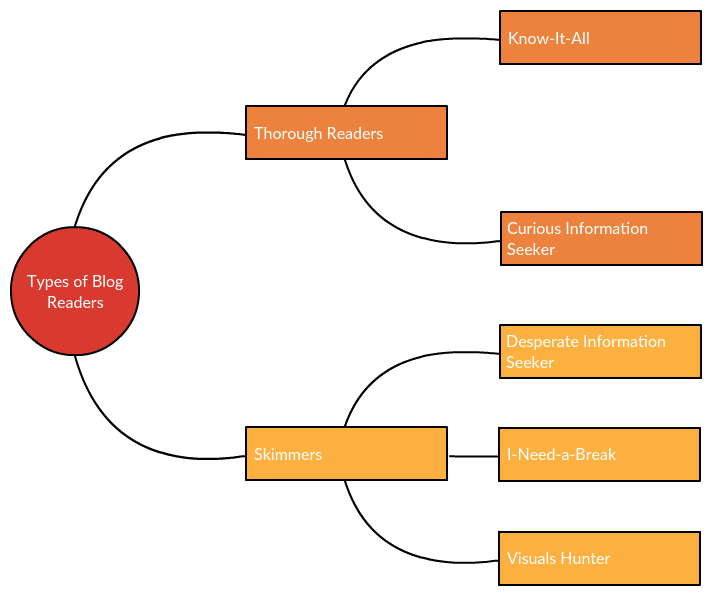
More often than not when we write, we seem to forget that the members of our audience are different from each other; instead we focus more on the topic under discussion, the SEO aspect of the post and the niche the audience belongs to. As a result we end up writing a post for a general audience that we believe would respond to it equally.
Except this is not the case! Each individual blog reader has her own way of reading and understanding your post. Following are these different types of blog readers. Read on to find out how to write a blog post that can satisfy all of them at once!
Know-it-all
Yes, this type knows it all – genuinely so. Then why do they read your post at all, you wonder? Take it as a compliment. They come to read intrigued by the topic, eager to broaden their knowledge of the subject and sometimes to make sure that you know what you are talking about.
This type could be reading your post with a preformed perspective which your post could sway or reinforce. Then what your post should include are facts that are true, relevant and timely. Do your research thoroughly and base your post on the details that can help prove your point and are, of course, interesting and unique.
Information Seeker
Information seekers do not stumble upon your blog accidentally; they find you in search results and choose you. There are 2 kinds of information seekers.
- Desperate
For this kind of information seekers, you are only one source out of many other. They may skim through the post to find out if the information they are looking for is there, and if it is, then they will prioritize you, read through, refer to you etc.
- Curious
The curious kind is not as desperate because they don’t have a deadline looming above their heads. They also have enough time on their hands and what they are looking for is interesting information to quench their thirst to learn more. Plus they will read your post in its entirety with a relaxed mind.
Relevance to the topic matters to these types of blog readers more than credibility and timeliness. However it doesn’t mean the latter two elements are of less importance. As a writer, it’s your responsibility to provide these readers information that will educate them, instead of mislead them.
“I Need a Break!”
Most of us do it. When it gets hectic at work we take a break to recharge ourselves, and some of us would like to read something as a form of quick therapy. This kind of reader clicks on your post with the hope that it will deliver what the title promises, or in other words they click on your post because the title is of interest to them.
Introduction of the article is crucial to retain the attention of these readers. Plus visual elements, such as images, graphs, infographics, videos etc., serve them as incentives to keep on reading.
Visuals Hunter
Sometimes a picture speaks a thousand words and that’s enough for the reader. She’d rather analyze all that statistics on one single chart, follow through that long process with the help of a process flowchart, learn the tutorial with a video of less than 5 minutes, etc.
This type of readers will skip over paragraphs and paragraphs of words without a question because what they want are visuals of any form.
Relevant visuals that are self-explanatory are important to keep these readers interested. It’s through these visual elements will you be able to get them to actually read, at least a few of the paragraphs you’ve put effort into.
How to Write the Post That Can Please Them All
The types of readers mentioned above can be put into 2 categories; thorough readers and skimmers.

Although there are two categories, it doesn’t mean you have to write differently for each; you can appeal to them both by following the tips below.
- Credible and precise information
When you write something it is your responsibility to make sure that you offer your audience something true, useful and accurate. If you are referring to other sources, make sure they are credible (and don’t forget to give them credit).
- Grammar, spelling or punctuation errors
These errors are the worst enemies of effective writing. Before hitting publish, always proofread to see if there are grammar, spelling or punctuation errors.
- Short paragraphs and sentences
Short paragraphs are generally more readable than daunting long paragraphs that stretch on for half of the page.
Always make sure that your paragraphs don’t exceed more than 4 sentences, and begin each paragraph with a new point pertaining to the topic. This helps both skimmers and thorough-readers read better.
- Subheadings and bullet points
These two increase the readability and the scannability of a post. They act as bait for the skimmers, therefore make sure that the post’s subheadings elaborately summarize what follows them.
Also if you can make a list out of a set of information, don’t hesitate to seize the opportunity, for more bullet points there are the more uncluttered your blog post will be.
- Visual elements
Visual elements work the charm on all types of readers, whether they are reading your post because they are curious or bored, they’d enjoy the image, graph, video, diagram or the infographic. Each element will help the reader understand and memorize what you are trying to say better.
- Bold, Italics, Underline or Colors
Typography is a very special part of a blog post. From the title to the conclusion of the post, typography plays the role of getting the reader to pay attention to the significant information.
By using fonts of different sizes, styles and colors you can easily illustrate facts. It’s a great way to make sure that the reader doesn’t miss out on the important parts of the post.
Conclusion
All types of blog readers have one thing in common; the need to know. While you let them know, make sure to use the tips mentioned above in order to help them better understand and memorize what they learn from your post.
What type of blog readers do you find yourself roaming around in your blog? Do you have any special way of getting their attention?
About the Author
Amanda Athuraliya is the communication specialist/content writer at Cinergix, the team behind the development of the Creately Flowchart Software. She is an avid reader, a budding writer and a passionate researcher who loves to write about all kinds of topics.

mansi desai